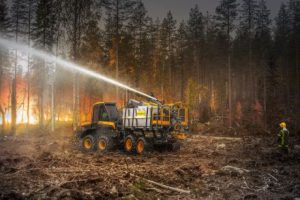
The forestry industry already controls the some of the largest coordinated private firefighting crews in Tasmania.
We know the coming fire season is shaping up to be potentially one of the worst on record.
Warnings have been issued by the TFS, the Bureau of Meteorology and leading scientists and other respected organisations.
Tasmanian government agencies and private organisations are already coordinating responses, and the forestry industry is keen to play its part.
As the working forests’ custodians, our industry is acutely aware of the risk of bushfire to our environment and regional communities.
We live and work in our state’s regional towns and forests, and our businesses can only succeed if our productive private and public forests are protected from fire. Put simply, burned forests are bad for our businesses.
We manage our production forests, and reducing fire risk is key to our future. It means we’re intrinsically tied to keeping our communities safe.
The active management of our production forests throughout its growth cycle, as well as vegetation reduction, not only makes our access to the estate easier, but also substantially reduces the fire risk.
It’s also key to remember that our forestry industry already controls the some of the largest coordinated private firefighting crews in Tasmania.
That’s why we are committed to working with all relevant State Government agencies to operate in a coordinated way – not only on direct firefighting activities, but also the ongoing fire mitigation actions that occur throughout the year.
The Tasmanian forestry industry knows that the best way to protect our working forests is ongoing prevention. But in times of crisis, we know that preparedness, response and recovery are also key factors.
And central to that response is communication. Our industry believes the newly released Tasmanian Government Radio Network (TasGRN) will be an essential tool in the state’s firefighting arsenal.
TasGRN is a digital, whole-of-government radio network. It will deliver public safety upgrades and functionality, especially during times of crisis.
For users it offers advanced security through encryption, better coverage across the state and allows inter-agency communications at times of emergency.
However, it creates a two-tier system when it’s most critical to have all stakeholders – government and non-government – working together.
TasGRN will ensure all government agencies will communicate effectively together, but it leaves non-government stakeholders, such as the state’s private plantation sector, out of the loop, stuck using the outdated UHF radio networks.
That’s why the TFPA is calling for the network to be expanded to private plantation estate owners when bushfires and other emergencies threaten their lands and businesses.
We’ve seen the importance the forestry industry can play in bushfire crisis, such as in the dreadful 2019/2020 bushfires on the mainland.
Local foresters were able to make a massive difference through their direct firefighting on the forest floor, as well as being able to drive firebreaks through to stop blazes threatening other communities.
Our businesses are based in the forest, we have the heavy equipment and machinery needed to fight the fires already on site, and we can respond immediately when our estates are threatened.
But for our own safety, and to ensure we can offer the most benefit, we need to have open lines of communications with other agencies.
That’s why our forest industry needs access to the TasGRN network.
We stand on the precipice of a looming fire crisis. The forestry industry is ready to make a huge impact, and we call on the Government to share with us the resources that will allow us to keep our working forests and our communities safe.
Nick Steel is the CEO of the Tasmanian Forest Products Association.





